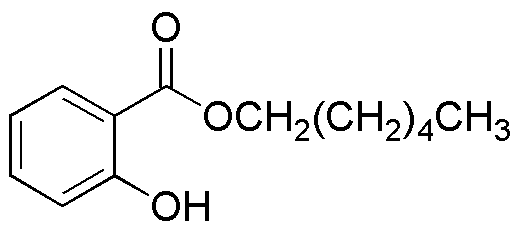Hexyl salicylate is widely utilized in research focused on:
- Fragrance Industry: This compound is commonly used in perfumes and scented products due to its pleasant floral aroma, enhancing the overall fragrance profile.
- Cosmetics: It serves as a fragrance ingredient in lotions, creams, and other personal care items, providing a sensory appeal while also offering skin-conditioning properties.
- Food Industry: Hexyl salicylate can be found in flavoring agents, contributing to the taste and aroma of various food products, making them more appealing to consumers.
- Pharmaceuticals: It is used in some topical formulations, where it can act as a solvent or carrier for active ingredients, improving their absorption and effectiveness.
- Research Applications: In scientific studies, hexyl salicylate is used as a model compound to understand the behavior of esters in various chemical reactions, aiding in the development of new materials.
General Information
Properties
Safety and Regulations
Applications
Hexyl salicylate is widely utilized in research focused on:
- Fragrance Industry: This compound is commonly used in perfumes and scented products due to its pleasant floral aroma, enhancing the overall fragrance profile.
- Cosmetics: It serves as a fragrance ingredient in lotions, creams, and other personal care items, providing a sensory appeal while also offering skin-conditioning properties.
- Food Industry: Hexyl salicylate can be found in flavoring agents, contributing to the taste and aroma of various food products, making them more appealing to consumers.
- Pharmaceuticals: It is used in some topical formulations, where it can act as a solvent or carrier for active ingredients, improving their absorption and effectiveness.
- Research Applications: In scientific studies, hexyl salicylate is used as a model compound to understand the behavior of esters in various chemical reactions, aiding in the development of new materials.
Documents
Safety Data Sheets (SDS)
The SDS provides comprehensive safety information on handling, storage, and disposal of the product.
Product Specification (PS)
The PS provides a comprehensive breakdown of the product’s properties, including chemical composition, physical state, purity, and storage requirements. It also details acceptable quality ranges and the product's intended applications.
Certificates of Analysis (COA)
Search for Certificates of Analysis (COA) by entering the products Lot Number. Lot and Batch Numbers can be found on a product’s label following the words ‘Lot’ or ‘Batch’.
*Catalog Number
*Lot Number
Certificates Of Origin (COO)
This COO confirms the country where the product was manufactured, and also details the materials and components used in it and whether it is derived from natural, synthetic, or other specific sources. This certificate may be required for customs, trade, and regulatory compliance.
*Catalog Number
*Lot Number
Safety Data Sheets (SDS)
The SDS provides comprehensive safety information on handling, storage, and disposal of the product.
DownloadProduct Specification (PS)
The PS provides a comprehensive breakdown of the product’s properties, including chemical composition, physical state, purity, and storage requirements. It also details acceptable quality ranges and the product's intended applications.
DownloadCertificates of Analysis (COA)
Search for Certificates of Analysis (COA) by entering the products Lot Number. Lot and Batch Numbers can be found on a product’s label following the words ‘Lot’ or ‘Batch’.
*Catalog Number
*Lot Number
Certificates Of Origin (COO)
This COO confirms the country where the product was manufactured, and also details the materials and components used in it and whether it is derived from natural, synthetic, or other specific sources. This certificate may be required for customs, trade, and regulatory compliance.


